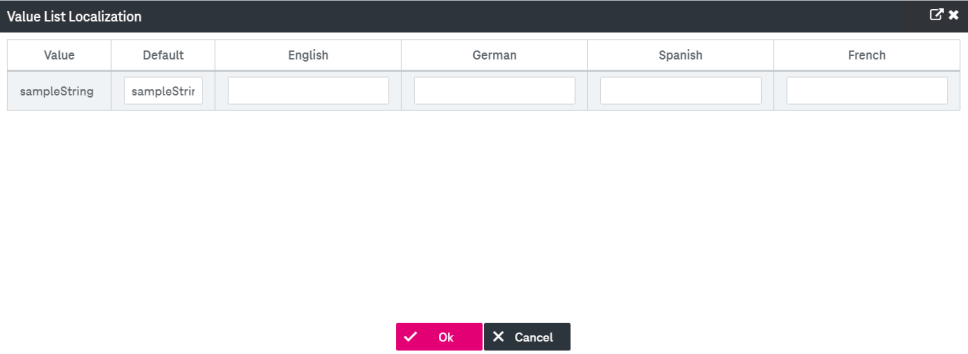On the Attributes tab select an attribute from the list box and click the Constraints subtab to adjust the restrictions of allowed values. The exact view of the screen depends on the attribute type (see figure Document types – attributes ). For example, you may define several constraints for strings and only the minimum and maximum value for a decimal attribute. All fields that are not supported for the current attribute type are disabled. For some attribute types, e.g. “Text”, all constraint fields are disabled.
The figure below provides an example of the constraints for the attribute of the type “String”:

Figure 96: Document types – attributes: constraints for the type “string”
To specify constraints, enter values in the appropriate fields. See table Document types – attributes: constraints below for more information.
Each value has a separate visible flag. By default all values are visible. The legacy values that should not be used anymore can be set invisible and they will no longer be displayed when creating / updating values (the only exception is a case when legacy value is the current value).
Only for the type “String”, the Value Set area of the screen is enabled. See the section Value set for the “string” attribute below for details.
|
Parameter |
Description |
|---|---|
|
For attribute type: Decimal |
|
|
Minimum Value |
The attribute value has to be equal or greater than this value. |
|
Maximum Value |
The attribute value has to be equal or lower than this value. |
|
Precision |
The value defines the number of digits in a decimal number. |
|
For attribute type: Date |
|
|
From-Date |
The attribute value has to be equal or later than this date. Use a date / time picker to enter the value. See chapter Date / time pickers. |
|
To-Date |
The attribute value has to be equal or earlier than this date. See chapter Date / time pickers. |
|
For attribute type: String |
|
|
Minimum Length |
The value defines the minimum number of characters of the string. The value defines a minimum length of a search attribute and of an attribute on document creation. |
|
Maximum Length |
The value defines the maximum number of characters of the string. The value defines a maximum length of a search attribute and of an attribute on document creation. |
|
Regular Expression |
Based on a regular expression (see chapter Support of regular expressions), a pattern can be defined, which decides about the strings which are accepted as input. |
|
Value Set |
A list of acceptable values can be defined. See section Value set for the “string” attribute below. The list of values is displayed in the WorkplaceClient and can be used there to select and insert values. |
|
Create Database Constraint |
If enabled (default), based on the value set (see above) a database constraint is created that checks if input values are acceptable in create or update operations. Values that have not been specified in the list will be rejected. This option cannot be selected together with the described below option Allow Manual Input. |
|
Allow Manual Input |
If enabled, customized values can be inserted by a user. This option cannot be selected together with the described above option Create Database Constraint. |
|
Sort Alphabetically |
The parameter defines the sorting order for the entries of the value list in the search workspace and in the document details view, which is used for modifying a document.
|
Value set for the “string” attribute
For the type “String”, it is possible to specify a defined list of values that are allowed for this attribute. This list will be used in the client’s user interface by providing a selection of possible values in the Search and Archive panels (see [UM WorkplaceClient]).
The following actions are available on the Value Set section of the screen (see figure Document types – attributes: constraints for the type “string”):
-
add a value
-
remove previously added values
-
localize values list in other languages
To add a value
-
Enter the desired value in the Value Set field.
-
Click Add Value(s).
-
Click Save.
To remove a value
-
Select the value in the list box.
-
Click Remove Selected Value.
-
Alternatively, click Remove All Values to clear the entire list.
-
Click Save.
To localize a values list in other languages
For each value, you can define a localized string representation. The localized values will be shown in the client’s user interface in the Search and Archive panels (see [UM WorkplaceClient]).
English is always used as the default language. Thus, if you omit a value for a specific language and a user is logged in using this language, the respective value is shown in English. If neither the English term nor the term for the selected language is defined, the base value is used for the display.
-
Select a value in the list and click Advanced.
The Value List Localization dialog is displayed. It contains a grid list of values with fields in all languages supported in ImageMaster.

Figure 97: Document types – attributes: values localization
-
Enter the value name in all required languages.
-
Click Ok.